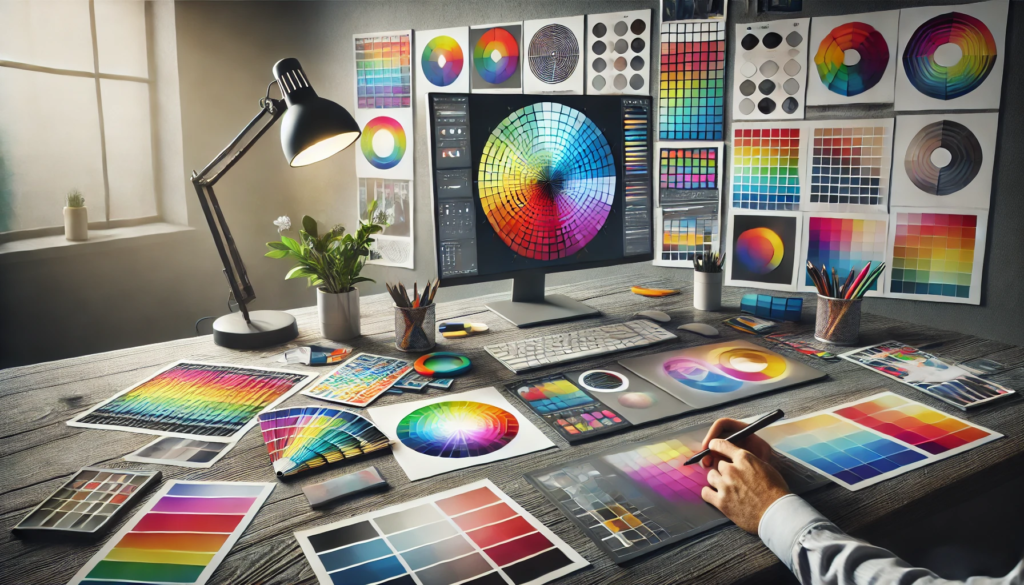Color theory is one of the most fundamental aspects of graphic design. It serves as the foundation for creating visually appealing and effective designs, influencing how viewers perceive and engage with content. Whether you’re designing a logo, website, poster, or any other project, understanding and applying color theory can enhance the visual impact and communication of your work.
This article will break down how you can apply color theory to your graphic design projects, from selecting harmonious color combinations to evoking specific emotions with your choices. Mastering color theory allows you to create designs that not only look good but also resonate with your target audience.
What Is Color Theory?
Color theory is the framework that guides how colors are used and combined in design. It involves understanding how colors interact with each other, the emotions they evoke, and how they affect visual hierarchy and readability. The basic building blocks of color theory include:
- The Color Wheel: A circular diagram of colors, used to understand relationships between primary, secondary, and tertiary colors.
- Color Harmonies: These are combinations of colors that are visually pleasing when used together, such as complementary, analogous, and triadic schemes.
- Color Properties: This refers to hue, saturation, and brightness, which define a color’s appearance.
By using color theory, designers can create harmonious color palettes that enhance the visual appeal and functionality of their projects.
The Color Wheel and Its Importance
The color wheel is a tool that helps designers visualize how colors relate to each other. It shows the primary colors (red, blue, yellow), secondary colors (green, orange, purple), and tertiary colors, which are combinations of primary and secondary colors.
The color wheel is critical for understanding color harmony and choosing colors that work well together. Here’s how the basic categories on the color wheel are defined:
Primary Colors
Primary colors—red, blue, and yellow—are the building blocks of all other colors. They cannot be created by mixing other colors and serve as the foundation for any color scheme.
Secondary Colors
Secondary colors—green, orange, and purple—are created by mixing two primary colors. For example, red and yellow create orange, blue and yellow make green, and red and blue combine to form purple.
Tertiary Colors
Tertiary colors are formed by mixing primary and secondary colors, resulting in more nuanced shades like red-orange or blue-green. These colors allow for more complex and visually interesting palettes.
Neutral Colors
Neutral colors like black, white, gray, and brown are not part of the traditional color wheel but play a vital role in design. They are often used to balance brighter colors or create a more subdued, minimalist look.
Color Harmonies: Building the Perfect Palette
Color harmony refers to the combination of colors that work well together and are pleasing to the eye. Using color harmonies ensures that your design feels balanced and unified. Below are some of the most common types of color harmonies used in graphic design.
Complementary Colors
Complementary colors are opposite each other on the color wheel (e.g., blue and orange, red and green). This contrast creates a vibrant look and can make key elements stand out. Complementary color schemes are great for logos, call-to-action buttons, or any design element that needs to grab attention.
However, using complementary colors in large areas can be overwhelming, so it’s best to use them strategically in smaller doses or as accent colors.
Analogous Colors
Analogous color schemes use colors that are next to each other on the color wheel, such as blue, blue-green, and green. These combinations are visually harmonious and are often found in nature, making them ideal for creating a calm, cohesive design. Analogous colors are great for backgrounds, illustrations, and projects where you want to evoke serenity and unity.
The key to using analogous colors effectively is ensuring one color dominates while the others support or accentuate it.
Monochromatic Colors
Monochromatic color schemes are built from one color but use different shades, tints, and tones. This creates a cohesive and elegant design that is simple yet visually effective. Monochromatic schemes are excellent for minimalist designs or projects that require a unified, polished look.
While monochromatic schemes are straightforward, they can sometimes feel flat. To add depth, use varying textures or contrast between light and dark shades.
Triadic Colors
Triadic color schemes use three colors that are evenly spaced around the color wheel, such as red, yellow, and blue. This creates a vibrant and balanced look. Triadic schemes are often used in playful, energetic designs, as they provide a wide range of color while maintaining harmony.
To avoid overwhelming the viewer, it’s best to let one color dominate and use the other two as accents.
The Psychology of Color: Eliciting Emotional Responses
Color has a significant psychological impact and can influence emotions and perceptions. By carefully selecting colors based on their psychological effects, you can strengthen your design’s message and evoke the desired response from your audience.
Red
Red is a powerful and attention-grabbing color. It is often associated with passion, excitement, and urgency. However, red can also signify danger or caution. In design, red is commonly used for buttons (like “Buy Now” or “Subscribe”), warning messages, or to create a sense of urgency.
Blue
Blue evokes calmness, trust, and professionalism. It’s often used by brands that want to convey stability and reliability, such as banks or tech companies. Blue is also a popular choice for social media platforms and corporate websites because it fosters a sense of security.
Yellow
Yellow is associated with optimism, happiness, and energy. It grabs attention and adds a cheerful element to designs. However, too much yellow can feel overwhelming, so it’s best used in moderation as an accent color to highlight or brighten specific parts of a design.
Green
Green symbolizes growth, health, and nature. It’s widely used in designs related to environmental causes, health, and wellness. Darker shades of green can convey stability and wealth, while lighter shades feel fresh and rejuvenating.
Purple
Purple is often associated with luxury, creativity, and spirituality. In graphic design, purple can be used to create a sense of elegance and sophistication, especially in industries related to beauty, fashion, and high-end products.
Orange
Orange combines the energy of red with the optimism of yellow. It’s often used to create a sense of enthusiasm and fun. Orange is an excellent choice for brands that want to be seen as friendly, playful, and energetic.
Black and White
Black is a bold and powerful color that signifies sophistication, elegance, and mystery. It’s often used for luxury brands and can create a strong contrast when paired with bright colors. White, on the other hand, represents simplicity, cleanliness, and minimalism. Together, black and white create a timeless and classic look.
Color in Branding and Visual Identity
Color plays a crucial role in branding, as it helps establish a brand’s identity and communicates its values. Consistent use of brand colors across all platforms helps create a cohesive and memorable brand experience. When choosing colors for a brand, consider how each color will resonate with your target audience and the emotions you want to evoke.
Choosing Brand Colors
When developing a brand’s color palette, aim for a balance between emotional resonance and practicality. You may want to start with a primary color that represents your brand’s core message and then select secondary and accent colors to complement it. Use neutral tones like black, white, or gray to balance the brighter colors.
- Primary Colors: These are the dominant colors that define the brand’s identity. They should align with the brand’s personality and values.
- Secondary Colors: These colors support the primary color and add variety to the design.
- Accent Colors: Used sparingly, accent colors draw attention to important elements like calls-to-action or special offers.
Consistency in Branding
Using your brand colors consistently across all materials—from websites and social media to packaging and advertisements—helps reinforce your brand’s visual identity. This consistency not only strengthens brand recognition but also builds trust with your audience.
Accessibility and Color Contrast
Accessibility is a critical aspect of graphic design, especially when it comes to choosing colors. Designers need to ensure that their color choices are inclusive and accessible to people with visual impairments, such as color blindness.
Color Contrast
High contrast between text and background colors improves readability and ensures that the content is accessible to everyone. For example, dark text on a light background or vice versa provides strong contrast and enhances legibility. Use online tools like WebAIM’s Contrast Checker to test your color combinations and ensure they meet accessibility standards.
Avoiding Reliance on Color Alone
Avoid relying solely on color to convey important information, especially in charts, graphs, or navigation elements. Use text labels or icons to provide additional context. This makes the design usable for people who may not perceive colors in the same way, ensuring that the content is accessible to a broader audience.
Testing and Refining Your Color Choices
Once you’ve selected your color palette, it’s essential to test how the colors work together in real-world scenarios. Consider creating mockups or prototypes to see how the colors function across different mediums, such as digital screens, print, or packaging.
A/B Testing
A/B testing involves creating two versions of a design with slight variations in color and then testing which version performs better. This is especially useful for marketing materials like ads, landing pages, or social media posts. By measuring user engagement and conversions, you can determine which color combinations resonate best with your audience.
Consider Cultural Differences
Colors can have different meanings in different cultures. For example, white is associated with purity in Western cultures but can symbolize mourning in some Eastern cultures. When designing for a global audience, consider cultural connotations to avoid misunderstandings or negative associations.
Conclusion
Using color theory in graphic design projects is essential for creating visually compelling and effective designs. By understanding the principles of color harmonies, psychological effects, and accessibility, designers can craft designs that not only look great but also communicate clearly and resonate with their audience.
Whether you’re building a brand identity, designing a website, or creating social media content, mastering color theory will enhance your ability to deliver impactful, emotionally engaging visual experiences.
FAQ
What is the color wheel in graphic design?
The color wheel is a circular diagram that shows the relationships between colors, helping designers choose harmonious combinations. It includes primary, secondary, and tertiary colors, forming the foundation of color theory.
How does color affect design?
Color affects design by influencing mood, emotions, and the overall perception of a piece. It helps create contrast, visual hierarchy, and emphasis, guiding viewers’ attention to key elements of the design.
What are complementary colors?
Complementary colors are pairs of colors that are opposite each other on the color wheel, such as red and green or blue and orange. These combinations create strong contrast and are often used to highlight important elements.
How do I choose colors for branding?
To choose brand colors, consider your brand’s personality, values, and target audience. Use a primary color that reflects your core message, supported by secondary and accent colors for variety and emphasis.
Why is color contrast important in design?
Color contrast is important because it ensures that text and other elements are legible, especially for users with visual impairments. High contrast between text and background improves readability and accessibility.
Can I use multiple color harmonies in one design?
Yes, you can combine different color harmonies in a single design, but it’s important to maintain balance. For example, you might use a complementary color scheme for the main design and add analogous colors for subtle accents.

